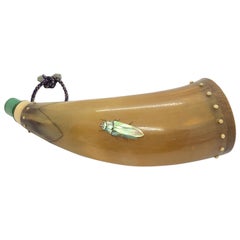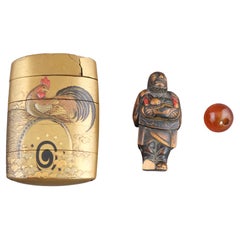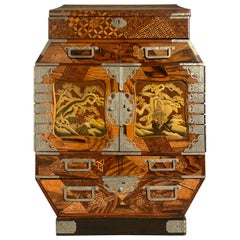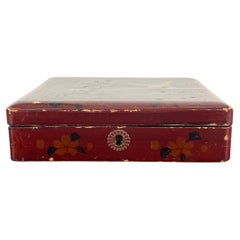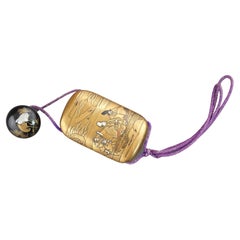Stockholm - More Asian Art, Objects and Furniture
2
to
1
1,155
1,039
2
2
2
2
1
1
1
1
1
2
2
2
Item Ships From: Stockholm
Japanese Powder Horn with Inlay in Mother of Pearl, 19th Century
Located in Stockholm, SE
A fantastic Japanese powder horn. The horn has inlay of mother of pearl in the shape of a grasshopper. The Japanese craftsmanship at its best.
Category
Late 19th Century Japanese Antique Stockholm - More Asian Art, Objects and Furniture
Materials
Horn
Japanese Inro with Netsuke, Late 19th C
Located in Stockholm, SE
A high quality lacquer inro with a carved wooden netsuke. Both are unfortunately damaged but still very nice art pieces. The way the rooster is executed is just exquisite.
Category
Late 19th Century Japanese Antique Stockholm - More Asian Art, Objects and Furniture
Materials
Boxwood, Lacquer
Related Items
Large Japanese Marquetry Table Cabinet, Meiji Period, Late 19th Century, Japan
Located in Austin, TX
A fine and unusually large Japanese table cabinet or jewelry chest with yosegi marquetry work and lacquer paneled doors, Meiji period, late 19th century, Japan.
The oversized tab...
Category
1890s Japanese Meiji Antique Stockholm - More Asian Art, Objects and Furniture
Materials
Brass
Free Shipping
H 24.5 in W 17.5 in D 8.75 in
Japanese Lacquered Box Decorated with Birds and Foliage, Signed, Late 19th
Located in Beuzevillette, FR
Japanese lacquered box decorated with birds and foliage
signed
Lacquered inside and outside
Late 19th Century
Without key
Some scratches and losses
Ideal for storing jewelry.
Category
Late 19th Century Japanese Antique Stockholm - More Asian Art, Objects and Furniture
Materials
Wood
H 1.78 in W 5.91 in D 7.09 in
Old Work Bowl with Japanese Lacquer / Meiji-Taisho / Urushi
Located in Sammu-shi, Chiba
A wooden vessel used from the Meiji era to the Taisho era.
Probably a beech tree.
It is made by hollowing out.
It's very cool, isn't it?
It is a round bowl made of one piece of wood...
Category
Mid-20th Century Japanese Taisho Stockholm - More Asian Art, Objects and Furniture
Materials
Beech, Lacquer
Meiji Period 19th Century Japanese Cloisonné Charger
Located in Lambertville, NJ
Lovely large Japanese cloisonné enamel charger Meiji Period (1868-1912). Measure: Large 14 inch.
Intricate enamel over brass cloisonné portraying a colorful floral and foliage motif...
Category
1890s Japanese Meiji Antique Stockholm - More Asian Art, Objects and Furniture
Materials
Copper
19th Century Antique Japanese Meiji Bronze Floor Lamp
Located in Point Richmond, CA
19th century antique Japanese Meiji bronze floor lamp.
This finely cast, well composed, pedestal lamp depicts mythical creatures on the base, cranes in high relief on the stem are...
Category
Late 19th Century Japanese Meiji Antique Stockholm - More Asian Art, Objects and Furniture
Materials
Bronze
Japanese Gilt Tabako-Bon with Mother-of-Pearl Inlay
Located in Chicago, IL
This handled box is a Japanese tabako-bon, or 'tobacco tray,' used to store tobacco and smoking accessories. Believed to have evolved from the traditional...
Category
Mid-20th Century Japanese Stockholm - More Asian Art, Objects and Furniture
Materials
Mother-of-Pearl, Wood
Japanese Satsuma Incense Burner, Koro, Meiji Period, Late 19th Century, Japan
Located in Austin, TX
A fine and elegant Japanese Satsuma tripod incense burner, koro, with pierced metal lid, signed Eizan (?) Meiji Period, late 19th century, Japan.
The koro, or censer, features a stoneware body of slightly compressed globular form, supported on three short and squat legs. The wide mouth with a recessed metal rim, and topped by an openwork metal lid topped with overlapping chrysanthemum blossoms of silver repousse.
The body of the koro finely painted with fan shaped cartouches. The fans in the foreground with sprays of blossoming chrysanthemum. The fans in the background with intricate geometric brocade designs.
The shoulder of the incense burner decorated with cartouches formed as stylized chrysanthemum petals, and intricately decorated with geometric and floral brocade designs.
The painting finely done in raised gilt and polychrome enamels, including the highly desirable gosu blue...
Category
Late 19th Century Japanese Meiji Antique Stockholm - More Asian Art, Objects and Furniture
Materials
Silver, Metal
Japanese Lacquered Box Signed, Late 19th Century
Located in Beuzevillette, FR
Pretty Japanese lacquered box decorated with birds and foliage.
signed
Lacquered inside and outside
Late 19th century
Without key
Nice lock
Ideal for storing jewelry.
Category
Late 19th Century Japanese Antique Stockholm - More Asian Art, Objects and Furniture
Materials
Wood
Japanese Bamboo and Brass Kiseru Pipe, Late 19th Century
Located in New York, NY
A Japanese Kiseru pipe, circa 1870. This type of pipe was used to smoke small amounts of tobacco, and was a very popular way to smoke in Japan before the 20th century.
For decora...
Category
1870s Japanese Edo Antique Stockholm - More Asian Art, Objects and Furniture
Materials
Brass
16th-Century Indo-Portuguese Colonial Mother-of-pearl Gujarat Casket
Located in Amsterdam, NL
An exceptional Indo-Portuguese colonial mother-of-pearl veneered casket with silver mounts
India, Gujarat, 2nd half of the 16th century, the silver mounts Goa or probably Lisbon
Measures: H. 16 x W. 24.6 x D. 16.1 cm
An exceptional Gujarati casket with a rectangular box and truncated pyramidal lid (with slopes on each side and a flat top) made from exotic wood, probably teak (Tectona grandis), covered with a mother-of-pearl mosaic. The tesserae, cut from the shell of the green turban sea snail (Turbo marmoratus, a marine gastropod) in the shape of fish scales, are pinned to the wooden structure with silver ball-headed nails. The casket is set on bracket feet on the corners. The masterfully engraved decoration of the silver mounts follows the most refined and erudite Mannerist repertoire of rinceaux and ferroneries dating from the mid-16th century. The high quality and refinement of the silver mounts and, likewise, the silver nails that replaced the original brass pins used to hold the mother-of-pearl tesserae in place indicate the work of a silversmith probably working in Lisbon in the second half of the 16th century.
The Indian origin of this production, namely from Cambay (Khambhat) and Surat in the present state of Gujarat in north India, is, as for the last three decades, consensual and fully demonstrated, not only by documentary and literary evidence - such as descriptions, travelogues and contemporary archival documentation - but also by the survival in situ of 16th-century wooden structures covered in mother-of-pearl tesserae. A fine example is a canopy decorating the tomb (dargah) of the Sufi saint, Sheik Salim Chisti (1478-1572) in Fatehpur Sikri in Agra district in the state of Uttar Pradesh, north India. This is an artistic production, geometric in character and Islamic in nature, where usually the mother-of-pearl tesserae form complex designs of fish scales or, similar to the dishes also made using the same technique, with the thin brass sheets and pins, stylized lotus flowers. The truncated pyramidal shape corresponds, like their contemporary tortoiseshell counterparts also made in Gujarat, to a piece of furniture used in the Indian subcontinent within the Islamic world prior to the arrival of the first Portuguese. This shape, in fact, is very old and peculiar to East-Asian caskets, chests or boxes used to contain and protect Buddhist texts, the sutras.
A similar chest is the famous and large reliquary chest from Lisbon cathedral that once contained the relics of the city's patron saint, Saint Vincent. Both match in shape, having the same kind of socle or pedestal and bracket feet, and in their engraved silver mountings, featuring the same type of refined, erudite decoration. Their differences lie in the silver borders that frame the entire length of the edges of the chest (both the box and the lid), pinned with silver nails, and on the lock plate, shaped like a coat of arms in the Lisbon example. Given the exceptional dimensions of the reliquary casket...
Category
16th Century Indian Antique Stockholm - More Asian Art, Objects and Furniture
Materials
Silver
Free Shipping
H 6.3 in W 9.69 in D 6.34 in
Porcelain Wall Plate, Japan, 19th Century
Located in Roma, IT
This porcelain wall plate is a decorative object manufactured in Japan at the end of the 19th century.
This refined wall plate is completely ma...
Category
1970s Japanese Vintage Stockholm - More Asian Art, Objects and Furniture
Materials
Porcelain
Japanese Porcelain Plate, Japan, End of the 19th Century
Located in Roma, IT
You are admiring a refined Japanese Porcelain plate made by Japan manufacture during the end of the 19th century.
This elegant decorative ...
Category
Late 19th Century Japanese Antique Stockholm - More Asian Art, Objects and Furniture
Materials
Porcelain
Previously Available Items
Ikupasuy, Wooden Carved Ceremonial Stick Used by Ainu Men When Making Offeri
Located in Stockholm, SE
This is a Ikupasuy, often referred to a mustache lifter. Carved wood with lacquer on top. Motives of a fish, probably a killer whale, surrounded by waves. The Ainu people is a small people...
Category
Late 19th Century Japanese Edo Antique Stockholm - More Asian Art, Objects and Furniture
Materials
Wood, Lacquer
H 13 in W 0.4 in D 1.26 in
Signed Japanese Inro with a Signed Round Lacquer Netsuke
Located in Stockholm, SE
A Japanese inro with a netsuke made in the late 19th c. Both signed by artist. The Inro as wells the netsuke are made of lacquer. the craftsmanship is ex...
Category
Late 19th Century Japanese Antique Stockholm - More Asian Art, Objects and Furniture
Materials
Lacquer
Japanese Inro with Its Netsuke, Late 19th C.
Located in Stockholm, SE
A nicely executed Japanese inro with a netsuke. The inro is made of lacquer and the netsuke carved from wood, boxwood. Boxwood is a very hard wood and of...
Category
Late 19th Century Japanese Antique Stockholm - More Asian Art, Objects and Furniture
Materials
Boxwood, Lacquer
Inro, Japanese, 19th Century
Located in Stockholm, SE
An inro, Japanese, made of wood and with inlays of colored ivory in the shape of a grasshopper and partly lacquered, 19th century.
An inro is a traditional Japanese case for holdi...
Category
19th Century Japanese Antique Stockholm - More Asian Art, Objects and Furniture
Materials
Ivory, Wood, Lacquer
Wood Carved Netsuke
Located in Stockholm, SE
A Japanese wood-carved netsuke of a frog sitting on a poppy seed capsule, 19th century, signed.
Category
19th Century Japanese Antique Stockholm - More Asian Art, Objects and Furniture
Materials
Wood
Recently Viewed
View AllMore Ways To Browse
Set Of 4 Bell Lanterns
Cloisonne Plate Cranes
Chinese Wedding Lanterns
Antique Chinese Bronze Teapot
Bronze Japanese Samurai On Dragon
Xia Dynasty
Ceramic Fowls
Antique Knitting Tool
Antique Knitting Tools
Naga Door
Samurai Ningyo Dolls
Asian Jade Bonsai
Carved Puzzle Ball
Burmese Kammavaca
Jadeite Snuff Bottle
Retro Chinese Wedding Basket
Peking Glass Snuff Bottle
Asian Wooden Shoes
